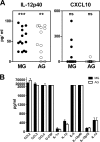Analysis of protein levels of 24 cytokines in scrapie agent-infected brain and glial cell cultures from mice differing in prion protein expression levels
- PMID: 19710140
- PMCID: PMC2772806
- DOI: 10.1128/JVI.01413-09
Analysis of protein levels of 24 cytokines in scrapie agent-infected brain and glial cell cultures from mice differing in prion protein expression levels
Abstract
Activation of microglia and astroglia is seen in many neurodegenerative diseases including prion diseases. Activated glial cells produce cytokines as a protective response against certain pathogens and as part of the host inflammatory response to brain damage. In addition, cytokines might also exacerbate tissue damage initiated by other processes. In the present work using multiplex assays to analyze protein levels of 24 cytokines in scrapie agent-infected C57BL/10 mouse brains, we observed elevation of CCL2, CCL5, CXCL1, CXCL10, granulocyte-macrophage colony-stimulating factor (GM-CSF), gamma interferon (IFN-gamma), interleukin 1alpha (IL-1alpha), IL-1beta, IL-6, and IL-12p40. Scrapie agent-infected wild-type mice and transgenic mice expressing anchorless prion protein (PrP) had similar cytokine responses in spite of extensive differences in neuropathology. Therefore, these responses may be primarily a reaction to brain damage induced by prion infection rather than specific inducers of a particular type of pathology. To study the roles of astroglia and microglia in these cytokine responses, primary glial cultures were exposed to scrapie agent-infected brain homogenates. Microglia produced only IL-12p40 and CXCL10, whereas astroglia produced these cytokines plus CCL2, CCL3, CCL5, CXCL1, G-CSF, IL-1beta, IL-6, IL-12p70, and IL-13. Glial cytokine responses from wild-type mice and transgenic mice expressing anchorless PrP differed only slightly, but glia from PrP-null mice produced only IL-12p40, indicating that PrP expression was required for scrapie agent induction of other cytokines detected. The difference in cytokine response between microglia and astroglia correlated with 20-fold-higher levels of PrP expression in astroglia versus microglia, suggesting that high-level PrP expression on astroglia might be important for induction of certain cytokines.
Figures






Similar articles
-
Enhanced M-CSF/CSF1R Signaling Closely Associates with PrPSc Accumulation in the Scrapie-Infected Cell Line and the Brains of Scrapie-Infected Experimental Rodents.Mol Neurobiol. 2022 Oct;59(10):6534-6551. doi: 10.1007/s12035-022-02989-y. Epub 2022 Aug 15. Mol Neurobiol. 2022. PMID: 35970974
-
Early cytokine elevation, PrPres deposition, and gliosis in mouse scrapie: no effect on disease by deletion of cytokine genes IL-12p40 and IL-12p35.J Virol. 2012 Oct;86(19):10377-83. doi: 10.1128/JVI.01340-12. Epub 2012 Jul 11. J Virol. 2012. PMID: 22787236 Free PMC article.
-
Role of cyclophilin A from brains of prion-infected mice in stimulation of cytokine release by microglia and astroglia in vitro.J Biol Chem. 2012 Feb 10;287(7):4628-39. doi: 10.1074/jbc.M111.269480. Epub 2011 Dec 16. J Biol Chem. 2012. PMID: 22179611 Free PMC article.
-
Molecular biology of prions causing infectious and genetic encephalopathies of humans as well as scrapie of sheep and BSE of cattle.Dev Biol Stand. 1991;75:55-74. Dev Biol Stand. 1991. PMID: 1686599 Review.
-
The neuropathological phenotype in transgenic mice expressing different prion protein constructs.Philos Trans R Soc Lond B Biol Sci. 1994 Mar 29;343(1306):415-23. doi: 10.1098/rstb.1994.0038. Philos Trans R Soc Lond B Biol Sci. 1994. PMID: 7913760 Review.
Cited by
-
Research progress on the NLRP3 inflammasome and its role in the central nervous system.Neurosci Bull. 2013 Dec;29(6):779-87. doi: 10.1007/s12264-013-1328-9. Epub 2013 Mar 20. Neurosci Bull. 2013. PMID: 23512739 Free PMC article. Review.
-
Anti-prion activity of Brilliant Blue G.PLoS One. 2012;7(5):e37896. doi: 10.1371/journal.pone.0037896. Epub 2012 May 31. PLoS One. 2012. PMID: 22693582 Free PMC article.
-
Identification of chemoattractive factors involved in the migration of bone marrow-derived mesenchymal stem cells to brain lesions caused by prions.J Virol. 2011 Nov;85(21):11069-78. doi: 10.1128/JVI.05318-11. Epub 2011 Aug 3. J Virol. 2011. PMID: 21813601 Free PMC article.
-
NLRP3 inflammasome activation in macrophage cell lines by prion protein fibrils as the source of IL-1β and neuronal toxicity.Cell Mol Life Sci. 2012 Dec;69(24):4215-28. doi: 10.1007/s00018-012-1140-0. Epub 2012 Aug 29. Cell Mol Life Sci. 2012. PMID: 22926439 Free PMC article.
-
Enhanced M-CSF/CSF1R Signaling Closely Associates with PrPSc Accumulation in the Scrapie-Infected Cell Line and the Brains of Scrapie-Infected Experimental Rodents.Mol Neurobiol. 2022 Oct;59(10):6534-6551. doi: 10.1007/s12035-022-02989-y. Epub 2022 Aug 15. Mol Neurobiol. 2022. PMID: 35970974
References
-
- Bell, M. D., R. Lopez-Gonzalez, L. Lawson, D. Hughes, I. Fraser, S. Gordon, and V. H. Perry. 1994. Upregulation of the macrophage scavenger receptor in response to different forms of injury in the CNS. J. Neurocytol. 23:605-613. - PubMed
-
- Beringue, V., M. Demoy, C. I. Lasmezas, B. Gouritin, C. Weingarten, J. P. Deslys, J. P. Andreux, P. Couvreur, and D. Dormont. 2000. Role of spleen macrophages in the clearance of scrapie agent early in pathogenesis. J. Pathol. 190:495-502. - PubMed
-
- Boillee, S., C. Vande Velde, and D. W. Cleveland. 2006. ALS: a disease of motor neurons and their nonneuronal neighbors. Neuron 52:39-59. - PubMed
-
- Brandner, S. 2003. CNS pathogenesis of prion diseases. Br. Med. Bull. 66:131-139. - PubMed
Publication types
MeSH terms
Substances
Grants and funding
LinkOut - more resources
Full Text Sources
Research Materials

